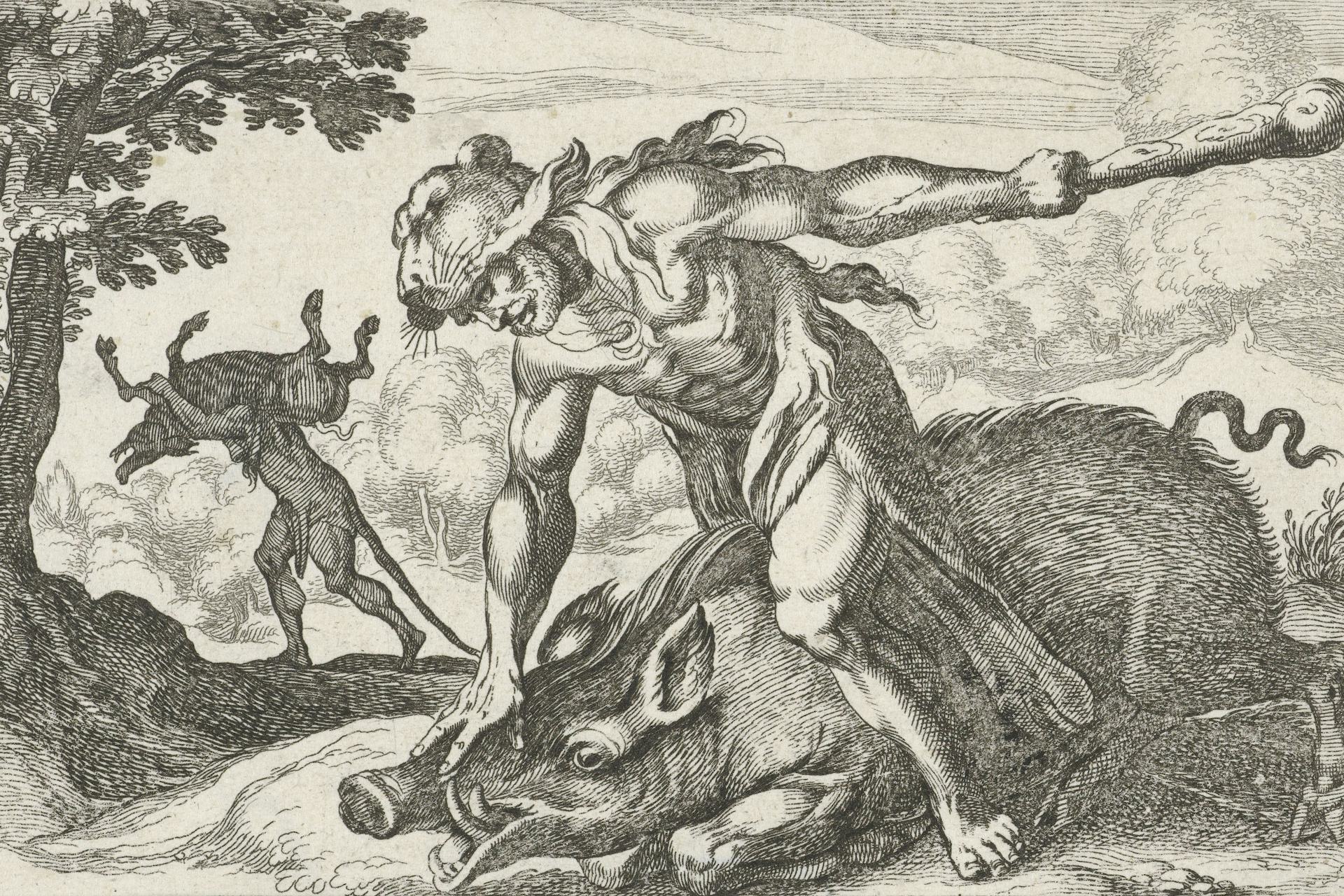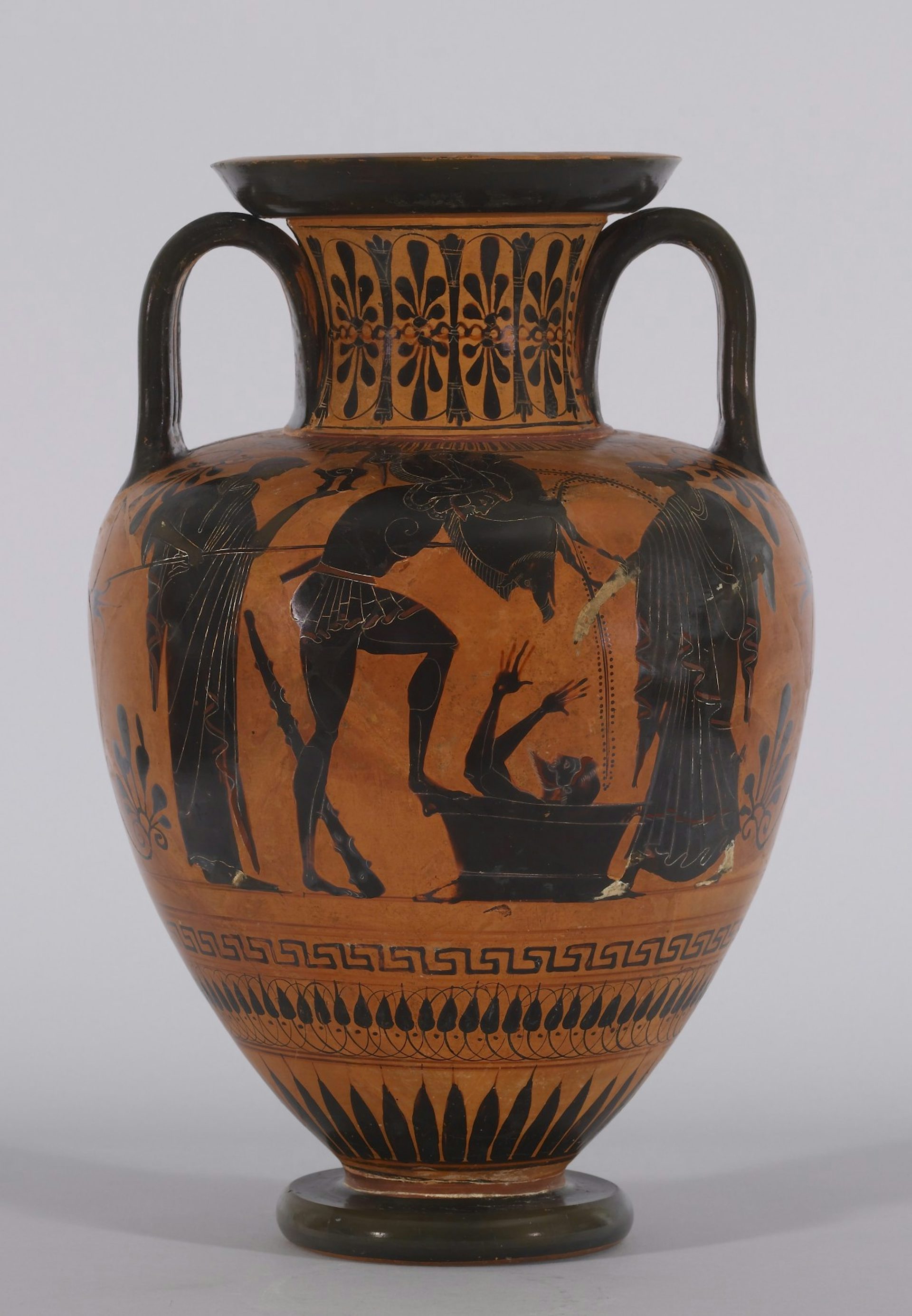Erymanthian Boar

Hercules catching the boar of Erymanthus by Simon Frisius, after Antonio Tempesta (ca. 1610–64).
RijksmuseumPublic DomainOverview
The Erymanthian Boar was possibly the least exciting creature of Greek mythology. As its name suggests, it was a boar, ordinary in every way except perhaps that it was aggressive enough to earn itself a moniker. The creature lived somewhere in the vicinity of Mount Erymanthus in the Peloponnese, around the regions of Arcadia, Achaea, or Elis.
The boar wreaked havoc in nearby towns until Heracles was sent to capture it for one of his Twelve Labors. After overpowering the beast, Heracles carried it back to his taskmaster, the Mycenaean king Eurystheus, who cowered inside a large jar to avoid the vicious animal.
Etymology
The Erymanthian Boar (Greek Ἐρυμάνθιος κάπρος, translit. Erymánthios kápros) was named after Mount Erymanthus, where it lived.
Pronunciation
English
Greek
Erymanthian Boar Ἐρυμάνθιος κάπρος (translit. Erymánthios kápros) Phonetic
IPA
[er-uh-MAN-thee-uhn bawr] /ˌɛr əˈmæn θi ən bɔr/
Attributes
Locales
The Erymanthian Boar lived somewhere in the Peloponnese; it was variously connected with locales in the regions of Arcadia, Elis, and Achaea. As the creature’s name suggests, it was chiefly associated with Mount Erymanthus, where it made its lair. Some authors claimed that whenever the boar came down from its mountain, it would torment the people of the town of Psophis;[1] others connected the boar with the towns of Lampeia,[2] Tegea,[3] or Maenalus.[4]
Appearance and Abilities
Unlike many creatures of Greek mythology, the Erymanthian Boar was just an ordinary animal, with no special powers or noteworthy features. According to classics scholar Timothy Gantz, “In no account is there anything especially remarkable about this boar, aside from its predictable ferocity.”[5] Nonetheless, it was a reasonably large and frightening boar, and it pestered the countryside around its lair, causing some harm to the inhabitants until it was captured by Heracles.
The tusks of the Erymanthian Boar were supposedly displayed in the Temple of Apollo at Cumae.[6] In some traditions, Heracles wore its hide after he defeated it, just as he wore the hide of the Nemean Lion.[7]
Iconography
The Erymanthian Boar—and in particular, its role in Heracles’ fourth labor—was a familiar subject in ancient art. Most representations of Heracles and the Erymanthian Boar did not treat the battle itself, but instead depicted Heracles carrying the boar alive on his shoulders. One especially popular motif showed Heracles holding the boar over his master Eurystheus, who hid in terror inside a pithos (a large conainer) buried in the earth.[8]

Attic black-figure neck amphora showing Heracles holding the Erymanthian Boar over Eurystheus as he cowers in a storage jar (ca. 520 BCE).
Walters Art MuseumCC0Mythology
The Fourth Labor of Heracles
The Erymanthian Boar was known exclusively for its role in Heracles’ famous Twelve Labors. These were assigned to the hero by Eurystheus, the king of Mycenae, who in turn was guided by Heracles’ divine nemesis, Hera. The labors were meant to destroy Heracles, but the inimitable hero was able to complete them all (much to Hera’s chagrin).
For his fourth labor (or third, in some sources), Heracles was sent to bring the Erymanthian Boar alive to Mycenae. The main challenge of this task was not so much the boar itself but rather the stipulation that it had to be captured alive.
Heracles dutifully journeyed to the Erymanthian Boar’s home on Mount Erymanthus and managed to catch the beast with a carefully planned attack. In one account, the hero used loud noises to drive the boar out of the undergrowth and then trapped it in the snow; another account added that his plan involved a stone-throwing element.[9] In only one source, Hyginus’ Fabulae, is Heracles reported to have slain the boar.[10]
Heracles then heaved the boar (still alive, at least in the standard tradition) upon his shoulders and carried it back to Mycenae—probably a more impressive feat than capturing the creature in the first place. According to Apollonius of Rhodes, it was on this journey back to Mycenae that Heracles heard about Jason’s quest for the Golden Fleece, and he took a detour to sail with him and the other Argonauts.[11]
Eventually Heracles arrived in Mycenae with the Erymanthian Boar. In one tradition—known from the author Diodorus of Sicily, but especially popular in ancient art—Eurystheus was seized with terror when he saw Heracles approaching the palace with the boar. He was so afraid that he found a large pithos, a kind of storage container, and hid in it while Heracles delivered the creature he had been sent to fetch.[12]
Pop Culture
The Erymanthian Boar still appears in some modern adaptations of Greek mythology, though it is nowhere near as familiar as many of Heracles’ other opponents, such as the Nemean Lion, the Hydra, and Cerberus.
In particular, the Erymanthian Boar can be found in contemporary retellings of the Heracles myth, including the TV series Hercules: The Legendary Journeys and the 2014 film Hercules. In one comedic reinterpretation of the myth, from Helen Eastman’s play Hercules, the Erymanthian Boar becomes the Erymanthian bore, a member of the Oxbridge aristocracy notorious for talking his interlocutors to sleep.
The Erymanthian Boar sometimes appears in video games too; for instance, the creature is the objective of one of the side quests in Assassin’s Creed: Odyssey.